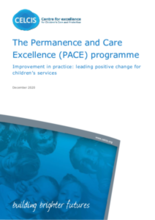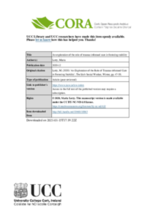Displaying 241 - 250 of 2214
This report provides an insight into the Permanence and Care Excellence (‘PACE’) programme – a Quality Improvement programme underway from 2014-2020 which engaged with local authority partnerships in 27 of the 32 Scottish local authority areas. The programme was aimed at supporting local authority partnerships across Scotland to reduce permanence planning timescales for looked after infants, children and young people using a Quality Improvement framework.
This paper explores the research from a collaborative between Tusla, the Child and Family Agency and University College Cork (UCC) that had an overarching aim to reduce fostering instability, in relation to its contribution to supporting fostering stability.
This study explored data obtained from surveys of caregivers who had previously adopted or assumed guardianship of a child from foster care in two U.S. states. Descriptive analyses summarized the demographic and wellbeing characteristics of children and families, and multivariate regression models estimated the association between these variables and caregiver commitment.
This paper aims to describe how a sense of normalcy for young people in foster care can be critical to their well-being.
This chapter from the book Racial Disproportionality and Disparities in the Child Welfare System explores disproportionality and disparities of Asian American and Native Hawaiian/Pacific Islander in the child welfare system.
This chapter from Racial Disproportionality and Disparities in the Child Welfare System explores the factors contributing to the disproportionate number of Black children and families in the U.S. child welfare system.
This chapter from Racial Disproportionality and Disparities in the Child Welfare System focuses on the macro level exploring the child welfare system as an explanatory factor using a critical race theory lens.
This paper discusses how research related to youth with experience in foster care can be conducted in an emancipatory manner with researchers actively supporting the liberation of youth with experience in foster care through their scholarly contributions.
The overrepresentation of black children in the foster care population represents massive state supervision and dissolution of families concentrated in their neighborhoods. This chapter from Racial Disproportionality and Disparities in the Child Welfare System addresses the social impact of this concentration of child welfare agency involvement on the residents who live in these neighborhoods.
Through careful ethnography and rich in-depth interviews at a non-profit foster care agency, this book takes a look behind the scenes of the U.S. foster care system.


